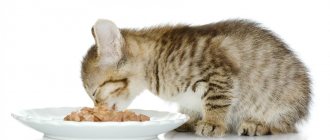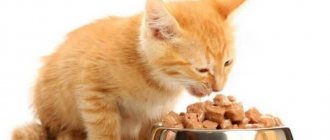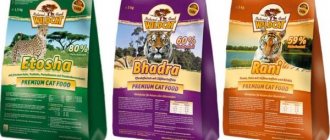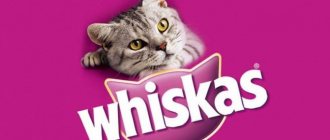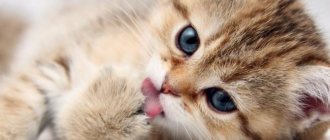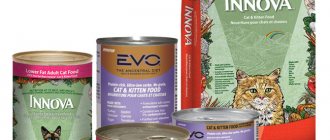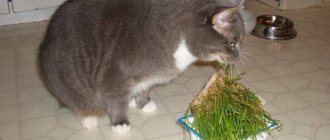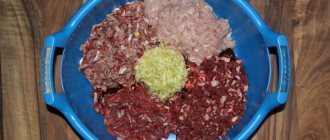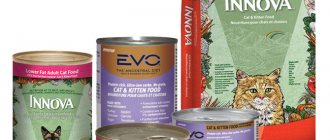After purchasing a pet, the owner inevitably has the question of what food to feed a British breed cat. Someone chooses natural nutrition: if it is properly balanced, then this option is better than any other. Some people choose industrial food because... it is faster, more convenient and does not require any skills from the owner. However, according to our calculations, approximately 90% of food on the CIS market is of questionable quality and should not be present in a cat’s bowl. What kind of food can you use?
What is the best food for British cats?
When answering the question of which food is most suitable for a British cat, one cannot fail to mention once again well-balanced natural feeding. Read about the evidence of its exceptional benefits. If you still decide to stick to industrial food, then read on in this article.
Article continues after advertisement
Feeding cats commercial food is suitable for people who:
- do not have time to prepare food for the cat: this requires approximately 2-3 hours a month;
- for some reason cannot deal with raw meat;
- unable to understand the peculiarities of natural feeding: there are people who cannot remember even the most basic information - it is better for them to buy ready-made food so as not to harm the animal;
- have a lot of money to buy quality food: good industrial food is expensive.
Feed can be wet or dry (dehydrated). Wet food is healthier than dry food because... It is important for cats to get plenty of fluids with their food. This is a prevention of urolithiasis, urinary tract infections, damage to the mucous membranes of the gastrointestinal tract and other problems. However, good wet food is more expensive, so consumers often choose dry food, not understanding why they should “overpay for water.” They are wrong, but we’ll talk about that later, but for now let’s talk about feed classes.
All food is divided into 4 classes, but the editors of the Murkotiki website also distinguishes a fifth class.
- Economy class. This is everything that is sold in supermarkets: Whiskas, Kitekat, 4 Paws, Felix, Friskies, etc. The composition of such feeds often does not indicate the percentage of ingredients and their origin. You can see, for example, the column “poultry meat”, but you cannot know what kind of bird it is: a crow killed on the road or a domestic chicken. Consumption of such feed has serious health consequences.
- Premium class. This is food that is a little better than economy class, and can be found on the shelves of supermarkets and veterinary clinics. This class includes Brit, Royal Canin, Trainer, Eukanuba, Monge, Nutra Mix, Pro Plan, etc. A sign of a premium class is that the composition contains a large amount of carbohydrates (mainly from cereals), meat of unknown origin (the type of meat is not specified) or “animal protein” without specifying details, the percentage of ingredients is often not indicated. There are other disadvantages as well.
- Super premium is slightly better than premium, however, some premium foods are better than some super premium foods. Below we will explain why this happens. Super-premium foods include 1st Choice, Leonardo, Brit Care, Pronature Life, Sanabelle, etc.
- Holistic . Marketers position these foods as specialized nutrition for solving certain health problems and sometimes even behavioral problems. For example, you can find food for a sterilized British cat, hypoallergenic food, food for cats with skin problems, for cystitis, after gastrointestinal infections, and others. In fact, holistic treatments do not always have a healing effect. And, according to the observations of the Murkotiki website, there are foods that say “holistic” on the packaging, but which actually harm and do not heal. Therefore, the fact that the package contains the addition “holistic” does not mean anything.
- Elite class . The Murkotiki website highlights this class separately. Most of the food in our rating can be attributed to this category. Such food cannot be found on supermarket shelves, but can be purchased in specialized online stores. They are expensive - more expensive than the meat from which they are made. The composition includes a large number of animal products, and the method of preparation is not carcinogenic high-temperature extrusion, but drying or processing at lower temperatures. The elite level requires 80% meat in the composition (ideally 90%), meat is always of known origin, not “horns and hooves” are used, but tenderloin and high-quality offal. The elite food included in the rating does not contain grains, legumes or potatoes.
The reader should understand that the division into classes is arbitrary. There is not a single official document regulating the specific criteria that food of a particular class must meet. Manufacturers themselves choose what to write on the packaging. Often, premium or holistic is no different from economy.
Moreover, low-quality food is sometimes prescribed to patients by veterinarians - and this only aggravates the problem. The editors of the Murkotiki website are often contacted by cat owners who have suffered from veterinarians’ recommendations regarding the choice of food. This, by the way, happens not only because of the illiteracy of doctors, but also because of their commercial interest in selling a particular brand. It has long been no secret that the owners of veterinary clinics enter into contracts with feed manufacturers and set sales plans for their subordinates.
EXPERTS' COMMENT: ADMINISTRATION OF THE ONLINE PET SUPPLIES STORE LAPA.SHOP
“The myth that high protein diets are bad for cats' kidneys is the result of marketing from poor quality food manufacturers. Diets high in plant proteins are hard on carnivore organs, while diets high in animal protein are not only beneficial, but necessary. Low quality pet food is loaded with protein from soy, corn, and other foods that are unhealthy for cats. This allows the manufacturer to increase the protein content of the food without actually offering the pets any protein they can digest. And veterinarians, with their illiterate statements about excess protein, are only trying to justify the sale by themselves of low-quality products of industrial giants. Big brand foods sold in veterinarians' offices may be marketed as premium, but just looking at the ingredients says otherwise. Formulas may contain several specialized ingredients to market themselves as a special diet, but in reality, they are no different from regular ones. And the education of a veterinarian does not include in-depth study of such disciplines as dietetics and small animal nutrition. Therefore, in the person of a veterinarian, you most often find nothing more than another seller of low-quality products.”
Can I feed them regular food?
It cannot be said that the definition of “ordinary food” is appropriate for the diet of British kittens. But home-cooked food is quite appropriate in their diet. You just need to approach the process of preparing it correctly. For example, you won’t be able to do without meat, because cats are carnivores by nature.
Beef
It is administered already in the first month of life, in the form of scraped meat fibers. You can also use minced meat without any additives. The meat is pre-frozen for at least three days, then thawed and doused with boiling water to destroy bacterial flora. Both fresh and chopped beef must be given without any additives; salt, spices, and onions in any quantities are excluded. As the pet grows, the meat is given cut into small pieces.
By-products
From the third month of life, the little Briton is ready to absorb offal. Boiled beef liver is introduced weekly as complementary food, and chopped offal (heart and other liver) is also mixed into the main food 3-4 times a week. One serving should not exceed 100 g.
Fish
Only sea fish is suitable, preferably in fillet form - without extra bones. Serve it raw or boiled to the kitten.
It is important to properly pre-treat the product. Freeze it for 3 days, and then pour boiling water over it to destroy helminth eggs.
Eggs
Egg yolk is a valuable source of vitamin D, which protects the baby’s bones from deformation, the development of rickets and other possible health problems. It is mixed into porridge and other dishes, after being crushed. The frequency of introduction into the diet is 1 time per week.
Porridge
The main source of nutrition for a kitten in the first months of life is food that does not require significant effort in absorption, but is nutritious and satisfying. This category includes all porridges, which are cooked differently at each age. For up to three months, food is cooked in milk with the addition of water, sugar is completely excluded. From the age of six months, the dish is given 3-4 times a week. They cook completely dairy-free rice, oatmeal, and semolina cereals.
Vegetables
An obligatory component of a British child's diet is boiled vegetables rich in fiber. Children are given carrots and cauliflower, chopping the ingredients and flavoring them with a small amount of vegetable oil. You can add prepared vegetables to the main meat dish or porridge.
Dairy products
The source of calcium in the kitten’s diet 3-4 times a week is fermented milk products - natural yoghurts without sugar or additives, cream, cottage cheese, kefir. You should choose a product with a low fat content.
Debunking the British food myth
Do not look for special food for British cats on sale, although they exist. Manufacturers who are not known for their high quality make such modifications, but their marketing departments work well. Let us take one of these foods for analysis to show by example that “food for the British breed” is nothing more than an advertising gimmick.
The manufacturer promises:
Article continues after advertisement
- maintaining muscle tone;
- joint protection;
- healthy teeth thanks to chelated calcium compounds and a special form of kibble, supposedly designed specifically for British cats (“makes it easier to grab and chew”);
- Heart health through taurine enrichment.
In this case, the manufacturer focuses on aspects that are relevant for the British breed - joints and heart. But now let’s look at the composition in order to understand how this food differs from others, except for the name.
Ingredients: dehydrated poultry protein, rice, animal fats, vegetable protein isolate, corn, vegetable fibre, corn gluten, hydrolyzed animal proteins, chicory, minerals, soybean oil, fish oil, fructo-oligosaccharides, hydrolyzed yeast, borage oil, hydrolysed crustacean shells, marigold extract.
All ingredients are listed without percentages. What kind of poultry meat and what animal fats were used is not specified. Rice and corn are harmful ingredients. These are the main, but not the only complaints about the composition, if we talk about cats in general. But still, our goal is not to analyze the composition as such, but to understand why this food is unique specifically for British cats.
- Maintaining muscle tone, which the manufacturer promises, is in fact achieved through physical activity and a high percentage of meat in the diet. The percentage of meat in this food is unknown. Usually this is not specified when there is little meat. The quality of the meat was also kept secret.
- All cats need joint protection, not just British cats. But for this purpose, nothing unique is provided in the food composition. All the same ingredients are in food for other breeds.
- All cats need taurine - it is an important amino acid found in meat. The British breed does not need individual standards for taurine intake, it simply needs a sufficient amount of it. True, the grains contained in this food, on the contrary, reduce the digestibility of all substances, including amino acids.
- Chelated calcium is absorbed better. This is a plus for healthy teeth, which, however, are needed not only by British cats. In our opinion, calcium in an easily digestible form should be present in any good food for any breed.
- The fact that dry food croquettes clean teeth is a myth long ago debunked by scientists. Dry food does not clean anything: teeth are cleaned either by chewing bones, or with a toothbrush with toothpaste, or with special solutions.
As you can see, the manufacturer did not offer anything unique for the British breed, and some of his assurances are generally false.
And for a snack, the most interesting thing: food for the Bengal breed (in many aspects this is the complete opposite of the British) from the same manufacturer contains absolutely similar ingredients, with the exception that for the unfortunate Bengals, the most harmful allergen - wheat - was also added to the food. At the same time, the manufacturer makes completely different promises about food for Bengals - with an eye on problem areas of the Bengal breed in order to attract the attention of the owners.
Vitamins and mineral supplements
If a British cat is fed natural products, vitamin and mineral complexes must be included in the diet. Many owners use natural supplements:
- Brewer's yeast;
- bone meal;
- fish fat.
The dosage appropriate for a particular pet is determined by the veterinarian.
A couple of times a year, it is beneficial for British cats to drink complex industrial supplements. They are used in courses of 1-3 months. Continuous use is fraught with health problems.
The following brands of vitamins have proven themselves to be effective:
- 8 in 1;
- Kitzyme;
- Gimpet;
- Omega Neo;
- Sanal;
- Veda Biorhythm;
- Canina.
There are also drugs on sale to eliminate problems with hair, internal organs, etc.
Dry food for British cats: rating
Our rating does not include not only economy-class food, but also more expensive brands such as Royal Canin or ProPlan for British cats, or even more expensive super-premium brands. You will find them in ratings on other sites that reprint information from each other without going into the intricacies of feline nutrition. Although premium food for British cats, and especially super-premium, is better than economy food, most of these foods are far from ideal. In addition, many of their ingredients, as well as the method of preparation, are harmful to the animal’s body. Read more about this in the article “The Truth About Cat Food.”
Our rating includes elite foods that are suitable for any breed and are expensive, but which we consider the only possible feeding option if the owner does not choose a natural diet of raw meat. The selection criteria are as follows.
- High content of animal ingredients (80% and above, but better than 90%) and low carbohydrate content (10% maximum, preferably 2-3%).
- Absence of products harmful to cats: grains, gluten, starch, citrus fruits, vegetable fats, legumes, etc.
- Indication of the percentage of ingredients (at least for meat and non-meat components).
- Indication of the origin of a particular type of meat: not just “poultry meat”, but “chicken meat”, “turkey meat”, etc.
- Preparation is not by hot extrusion, which is recognized as carcinogenic, but by drying or processing at low temperatures (up to 100 degrees Celsius).
- At the moment, no lawsuits or claims should be filed against the manufacturer regarding the content of heavy metals, exceeding the standards for the content of vitamins and minerals, etc.
General feeding rules
You can treat such a fluffy one with yogurt, but in moderation.
A growing body should be fed frequently - 6-9 times a day. In addition to dry food, a specialized milk formula should be added to the menu. If the owner prefers natural feeding, you can cook vegetable soup, porridge with milk or meat broth for the baby. It is useful to give ready-made fish without bones and skin, cottage cheese, eggs, natural yogurt.
Adult cats eat 2 times a day. It is important to give your pet food at the same time, having previously calculated the norm based on weight - 30-60 g of food per 1 kg of body weight. An adult Briton eats up to 300 g of ready-made factory feed or home-cooked food per day. The remains are removed from the bowl so that the animal does not have the habit of eating. For a neutered pet, the rules are the same. However, if previously the owner preferred to prepare home-cooked food for him, then after the operation it is recommended to completely switch the cat to ready-made food. It is important to ensure that clean water is always freely available, otherwise problems with digestion and dehydration cannot be avoided.
A cat aged 8-9 years is considered elderly. Old cats prefer to lead a sedentary lifestyle, so they need to buy special food, the composition of which takes these features into account. It is important to provide your pet with proper nutrition, more careful care, and monitor its health. Therefore, if you have questions regarding the menu, it is better to seek advice from a veterinarian.
Rating leaders
As a result of strict selection, the rating consists of only 5 foods. Even though I wanted to, I couldn’t get more, because... There are very few worthy products on the CIS market. If you search in foreign countries, you can find more, but these brands are not available to our cats, because... Nobody supplies them yet.
Please note that each rating place is assigned not to the manufacturer or brand as a whole, but to a specific modification of the food. There are manufacturers for whom only one modification of food was included in the rating, while the rest did not stand up to criticism. And vice versa: there is a manufacturer whose three food variations are at the top of the rating.
Ziwi Peak Air-Dried Mackerel&Lamb - the best food for British cats and other breeds
A manufacturer from New Zealand under the Z-Twintech brand offers several modifications of dry food that have undergone dehydration in air, that is, by drying, instead of harmful extrusion - processing of raw materials at high temperatures. Drying allows you to retain much more moisture - up to 14% than in regular dry food, which contains 7-10% moisture. This is important for the health of cats, because... They should get most of their water from food. Of course, 14% is not ideal. Ideal cat food contains at least 50% moisture, but among dry food, 14% is a very high figure.
We put ZiwiPeak Air-Dried Mackerel&Lamb food with mackerel and lamb in first place due to its diverse composition and high protein content.
Analysis: protein - minimum 43%, fat - minimum 25%, fiber - 2%, moisture - maximum 14%, ash - 12%, carbohydrates - less than 4% (carbohydrates according to the calculations of the Murkotiki website).
The manufacturer did not include such questionable ingredients as potatoes, sweet potatoes, beans, etc. At the same time, he reports the origin of all components. The fish are caught off the coast of New Zealand, and the lambs are raised on a New Zealand farm and are free-ranged.
Ingredients: mackerel, lamb, liver, tripe, heart, kidney, lung, New Zealand green-lipped mussel, lamb bone, lecithin, chicory inulin, dried seaweed, salt, preservative (citric acid and tocopherols), vitamin complex, DL-methionine , taurine.
Article continues after advertisement
The manufacturer did not specify the percentage of each ingredient: they are listed in descending order of quantity. But the manufacturer immediately stated that meat of animal origin in the food is 96%, of which about 3% is mussels. All other ingredients account for 4%.
If everyone is familiar with the first ingredients of the composition, then something as exotic as New Zealand mussels raises questions. These are shellfish whose meat is rich in glycosaminoglycans, which are important for the construction of connective and bone tissue. Thus, eating mussels helps maintain healthy joints and ligaments, which is important for the British breed, which has a powerful physique. Even the analgesic effect of glycosaminoglycans in arthritis has been proven.
Lecithin serves as a hepatoprotector, inulin from chicory acts as a prebiotic, and dried seaweed is a source of fiber. Citric acid and tocopherol (vitamin E) are natural preservatives. The complex is also additionally enriched with taurine and DL-methionine, amino acids important for the cat’s body.
2nd place: Ziwi Peak Air-Dried Venison with venison
In second place in our ranking is the ZiwiPeak Air-Dried Venison variation made from venison. It has approximately the same composition in terms of proteins and fats, but the food came in second place, because the first variation of ZiwiPeak Air-Dried Mackerel&Lamb also contained mackerel. We rated a greater variety of ingredients higher, although it is quite possible to put food from the Z-Twintech brand with venison in first place.
Ingredients: venison, liver, kidney, heart, tripe, venison lungs, New Zealand green-lipped mussels, venison bone, lecithin, chicory inulin, dried seaweed, salt, preservative (citric acid and tocopherols), DL-methionine, taurine.
The food is prepared in the same way as the first, and also contains 96% meat ingredients, including mussels. And 4% consists of plants and additives, which are also present in the first food. That is, in fact, the composition of the two foods is identical, the main ingredient is just different: in the first case it is mackerel and lamb, in the second it is venison and its by-products.
Analysis: protein - minimum 45%, fat - minimum 23%, fiber - maximum 2%, moisture - 14%, ash - 12%, carbohydrates - up to 4% (carbohydrates according to the calculations of the Murkotiki website).
As you can see, according to the guaranteed analysis of proteins, fats and carbohydrates, as well as moisture and fiber, the compositions are almost identical. The food that took the second position is 2% fattier and 2% richer in protein, which is not significant. Owners can use both the first and second numbers at different feedings or at different periods, without fear that as a result of alternation an imbalance will occur in the cat’s body.
3rd place: Ziwi Peak Air-Dried Beef
One of the modifications from the same manufacturer called Ziwi Peak Air-Dried Beef For Cats is created for allergy sufferers. It uses only one type of meat - beef with the addition of kelp, parsley, chicory and green mussels.
Ingredients: beef, beef liver, kidney, heart, tripe, bones, lungs, New Zealand green lipped mussels, beef bone, lecithin, chicory inulin, dried seaweed, salt, citric acid (preservative), tocopherols (preservative), DL-methionine , taurine.
The manufacturer indicates that the cows were raised on New Zealand farms and are free-grazing. The food is suitable for cats of any age and lifestyle. Contains 96% meat and organs. Among the organs there is green tripe that helps with digestion.
Analysis: protein - minimum 38%, fat - minimum 30%, fiber - maximum 2%, moisture - maximum 14%, ash - maximum 12%, carbohydrates - less than 4% (carbohydrates according to the calculations of the Murkotiki website).
The composition of the food is much higher in fat than the first two and contains less protein. Therefore, we can say that he is far ahead of the first two positions, differing for the worse. If your cat loosens her stool after eating this food, this is a sure sign that the food is too fatty for her.
However, indeed, for cats who are allergic to all meat except beef, this food is relevant. However, if your cat is allergic to beef, then this food will not be hypoallergenic for him.
Thus, Ziwi Peak food with beef can be recommended for allergy sufferers with a healthy pancreas and underweight, because, having a lot of fat, it can quickly bring the cat into a more well-fed state. Contraindicated for those who have a weak pancreas and a tendency to be overweight.
The price of Ziwi Peak food is approximately $30 per 400 gram package, i.e. they are very expensive.
4th place: Beutenah Markus Muhle with chicken - good dry food for British cats
Beutenah food from the German company Markus Muhle came in second to last place in the rating, because... The percentages for each ingredient are not indicated, although their ratio can be calculated. In addition, the manufacturer is less known than others and there are still few reviews about it. Nevertheless, we were interested in the composition and preparation technology.
The manufacturer promises ingredients without GMOs and harmful additives, preservatives, flavors, and chemical dyes. In addition, 98% of the proteins are of animal origin, which is very good, because... It is animal proteins that predators assimilate best.
Ingredients: chopped chicken meat, poultry fat, dried and ground liver, white fish oil, ground eggshells, psyllium, beet pulp, hemp oil, dried and ground chicory, New Zealand green-lipped mussel meat extract.
One thing you can find fault with in the composition is that the percentages for specific ingredients are not indicated. But with this reservation, we forgave the manufacturer for this omission, because It is indicated that the food contains a lot of crude protein, 98% of which is animal (i.e., high), and oils, vegetables and herbs are used as auxiliary ingredients (i.e., no harmful ingredients). Therefore, from the point of view of composition, analytical data on BZHU will be more interesting.
Analysis: protein - 59%, fat - 16%, fiber - 3.2%, ash - 8.2%, carbohydrates - approximately 4-6% (according to the calculations of the Murkotiki website).
Of the minuses: the type of animal from which the liver and fat was taken is not specified. It is clear that in chicken feed it is most likely chicken, but I would like to see a clarification from the manufacturer.
Hemp oil is a controversial ingredient in cat food. Some nutritionists are of the opinion that cats are not able to obtain useful substances from vegetable oil, because... they are predators. Other nutritionists believe that a small amount of beneficial substances that hemp oil is rich in will still remain in the cat’s body and play a role. Nutrients are understood primarily as fatty acids.
There are clear advantages: a high percentage of animal protein, a good percentage of fat content, plus the composition contains products that help digestion. These are psyllium (psyllium husk), beet pulp and chicory. But be aware that psyllium can occasionally cause adverse intestinal reactions (such as diarrhea): if you try this food, pay attention to the quality of the stool. If the cat becomes very weak, it means that he is experiencing such a rare reaction.
New Zealand green-lipped mussels are present in this food in the form of an extract and are in last place, i.e., most likely, they are used more as a natural flavoring than an ingredient that can actually have an impact on health.
A big plus of the food: the manufacturer claims that a cold press is used in the production process (temperature 35-45 degrees Celsius). The system does not heat the ingredients to high temperatures, thus reducing their nutritional value less significantly than does cooking. With the help of this technology, better digestibility is achieved, the aroma and taste of the raw materials are preserved.
In addition, no preservatives are added to the food. Because of this, the product has another drawback. However, lovers of everything natural will most likely attribute this to its advantages: Beutenah food is stored for no more than 6-8 months. When buying it, you need to pay special attention to the expiration date.
5th place: Wildcat Etosha with chicken
The German food brand Wildcat (owner - Healthfood24 GmbH) produces cat food Etosha (Etosha National Park in Namibia, Africa). The advertising slogan is the statement that the food contains about 80% meat ingredients.
Our rating included only the modification with chicken (with chicken, not chicken and turkey!). Its name is Wildcat Adult Etosha Chicken Grain Free. The rest of the food from this manufacturer did not withstand our criticism, because... contain legumes and potatoes.
The manufacturer assures that its food is free of preservatives, flavors and dyes, and its ingredients help strengthen the heart and immune system. Is it so? Let's get a look.
Article continues after advertisement
Ingredients: dehydrated chicken - 70.5%, fresh chicken - 8.5%, chicken fat, flaxseed, fennel, artichoke, blackberries, raspberries, blueberries, strawberries, sea salt, dried cranberries, mannanoligosaccharides (prebiotic), fructooligosaccharides (prebiotic), grape seed extract, thyme, marjoram, oregano, parsley, sage.
As you can see, in food, indeed, about 80% of the components are of animal origin. This is not enough, however, it is more than in those foods that were not included in our rating. And 20% of the components are berries, herbs, greens and roots, but they do not have nutritional value, because... cats absorb beneficial microelements mainly only from animal products. The purpose of adding these ingredients is different:
- flaxseed improves intestinal motility and promotes bile secretion;
- fennel (pharmaceutical dill) is a medicinal herb and has an anti-inflammatory effect, speeds up metabolism, but, contained in small quantities in food, most likely does not have a significant effect on the health of the pet;
- artichoke supports liver health;
- blackberries, raspberries, blueberries, strawberries are berries that are not natural food for cats, so they can rather be considered a source of fiber;
- dried cranberries support the genitourinary system and acidify urine, but the amount is not specified, so it is probably not enough to have this effect;
- mannanoligosaccharides and fructooligosaccharides are prebiotics that help digestion;
- grape seed extract is a source of antioxidants, however, being one of the last places, it is unlikely to have a significant effect;
- thyme, marjoram, oregano, parsley, sage are herbs that have bactericidal properties that improve digestion, but their addition is more of a marketing ploy (consumers tend to buy food with medicinal herbs, thinking that they benefit cats).
In our opinion, half of the vegetable list could easily be crossed out and more meat ingredients included instead. Apparently, the manufacturer wanted to attract the attention of consumers with medicinal herbs. But it is not a fact that these plants have a noticeable effect, because there is very little of each individual taken from them. Therefore, we would classify this part not as useful, but as neutral.
At the same time, there are no ingredients that are frankly harmful to cats, which are often present in grain-free diets, in this food. We could not help but note this achievement.
In terms of the ratio of proteins-fat-carbohydrates, the composition also turned out to be quite harmonious.
Analysis: protein - 53%, fat - 24%, carbohydrates - 3.5%, fiber - 2%, ash - 12.5%, moisture - 5%.
Etosha food can be considered low-carbohydrate: the indicator fits into the norm for carbohydrate consumption by cats in the wild - no more than 3%. Moreover, the manufacturer indicated the amount of carbohydrates himself, because 3.5% is a very good figure to brag about.
The manufacturer does not specify the technology for producing dry granules, but states that lower temperatures are used than with conventional extrusion, and that the products are processed immediately after entering the plant in order to preserve more nutrients.
Our verdict: Etosha food, like all the others, has its drawbacks, but it’s a stretch to make it into our rating, because... we consider it acceptable when feeding cats if more expensive options are not available.
Water in the diet
British cats should always have access to clean water. It is renewed 1-2 times a day - aristocratic Englishmen often refuse to drink stale liquid.
Water is especially necessary if the cat is fed dry kibble. They are dehydrated, so the pet drinks 2-3 times more than when eating natural food.
It is not recommended to give tap water to animals. It contains chlorine and other harmful impurities. Therefore, it is pre-filtered and settled. Some owners buy bottled water. Naturally, without gas.
conclusions
- The ideal diet for a British cat is a natural, properly balanced diet of meat. Any food, even the best one, will still not be better than a well-designed natural menu.
- When choosing dry food for British shorthair and longhair cats, you first need to pay attention to the composition. It should not contain prohibited ingredients such as grains, bone meal, etc.
- When choosing food, you cannot rely on reviews from friends, much less reviews on the Internet. Your friends may not understand that the food they choose is bad. Reviews on the Internet are often paid for by the manufacturer of low-quality food.
- Likewise, veterinarians cannot be relied upon to endorse certain brands. Be wary if your veterinarian insists on one specific food.
- You can't rely on a cat's taste either. Owners have the misconception that cats sense healthy food. In fact, this is not true. Cats are greedy for cheap flavored food: they get hooked on it like fast food. Your pet does not know which food is best for British breed cats. He will choose what smells stronger. And it’s the low-level food that smells strongly.
- Don't fall for marketing gimmicks like "food for British cats." The British breed needs the same percentage of nutrients as any other: its digestion is no different from the digestion of cats of other breeds.
- There are individual characteristics in specific animals that need to be taken into account. For example, some cats are allergic to chicken, others are allergic to beef, some cannot tolerate eggs, and some cannot stand fish. This must be taken into account when choosing a diet.
- A sign of high-quality food is a high price: it is always higher than the price of the meat from which the food consists. After all, in addition to purchasing products, the manufacturer has to spend money on manufacturing, packaging and distribution.
If you cannot afford high-quality expensive food, choose natural food, which, if properly balanced, will be healthier than even the most expensive factory-made food.
Rate and share!
How to create a balanced diet?
Each owner decides for himself whether his pet will eat only dry or wet food, and in what proportion the dishes will be combined. Standard options: 50/50, 70/30, 60/40%. In any case, the animal should always have access to clean water. And food should be poured into the bowl only during feeding - the rest of the time it should be clean. To create a balanced diet, you can follow the example of experienced breeders who recommend:
- alternate feeding with dry and wet food (in the morning it is better to introduce soft pieces in sauce or canned food into the diet, then feeding continues with dry food);
- You should regularly offer the animal meat cut into small pieces;
- You should not skimp on food for a purebred or elite animal, as this will lead to a deterioration in its health.
Reviews
When choosing food, much depends on the individual characteristics of the animal. Studying reviews from other owners will help you choose food and protect you from the most common mistakes.
Maria
When I decided to get a British dog, I spent a long time studying all the literature on this unusual breed. After consulting with a doctor, I decided to try natural food: I bought veal, chicken, and turkey for the kitten. She gave me quail eggs once a week. At first everything was fine, but then the animal began to have health problems: weak joints, faded fur, refusal to eat, vomiting. Switched to dry. She was one and a half years old at the time, so I immediately started with Royal Canin British Shorthair, for adults. The cat appreciated the size of the granules: they are convenient to chew. Soon the health problems completely disappeared, and now I feed my darling only piano.
Alexandra
I received the Briton as a small kitten. After testing with natural nutrition, I switched entirely to drying. The transition was difficult: the kitten did not want to eat it, and even tried to bury it. We tried 1st Choice and Acana. The second food is more suitable for animals with an active lifestyle, we abandoned it. In the end, we settled on Brit Care food, which is for kittens. The only downside I can name is the small granules, which are not always convenient to eat. Otherwise, the food is ideal. Everyone is happy.
What to feed a British kitten 1-6 months old: approximate diet and nutrition tips
In order for a new family member to fully develop and grow up absolutely healthy, it is necessary to develop the correct diet from the first days of the animal’s stay in the house. You will learn in our article what to feed a British kitten and what foods are best excluded from the menu of your four-legged friend. Take this issue seriously and responsibly, because healthy eating is the key to a long and happy life for your new furry friend!
A kitten of the British breed is an amazing animal with a beautiful face and funny manners! You won’t be bored with this pet; they are active and playful, but quite demanding in care.

